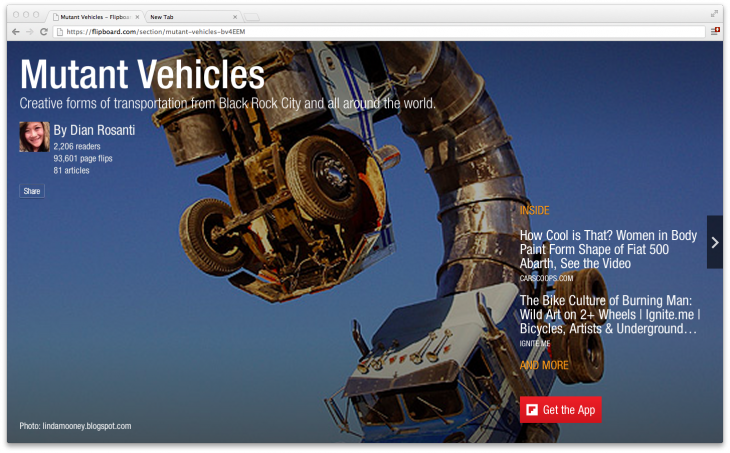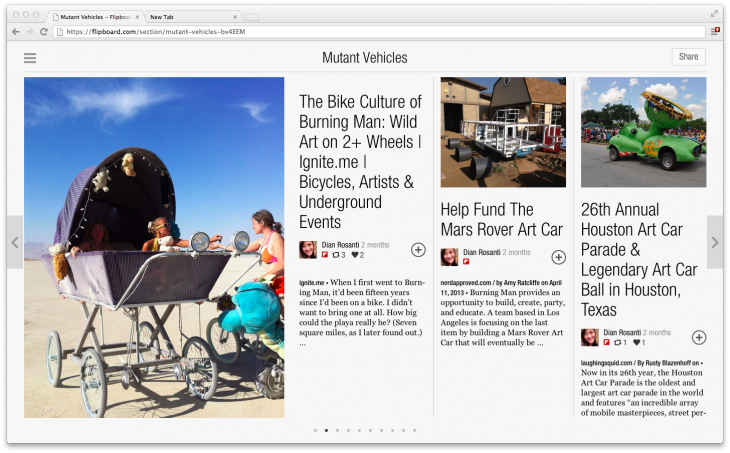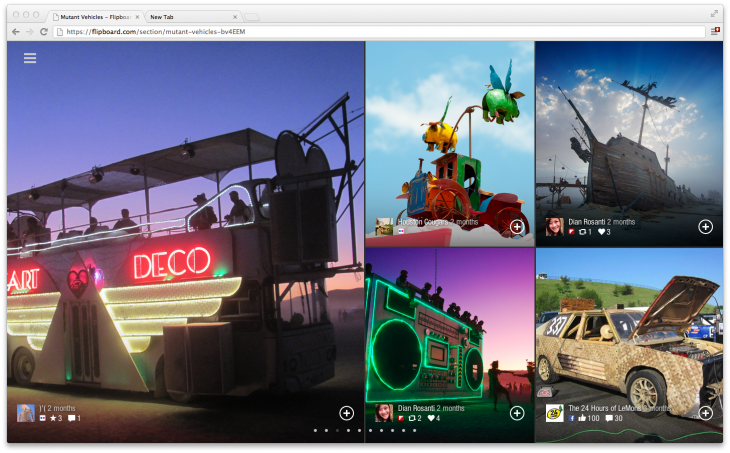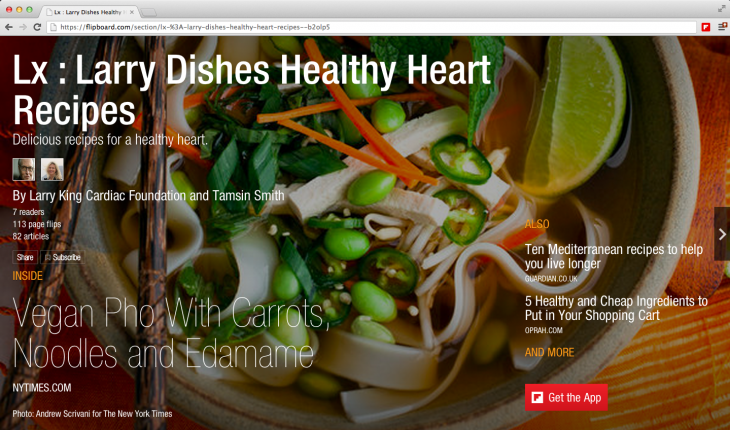
Flipboard today announced the arrival of its custom magazines on the Web, opening itself up to a whole new segment of users. Magazines can now be viewed regardless of what device and platform the reader is using. The company admits that the product isn’t quite where they want it to be, but today marks the first in a series of steps between now and 2014 before it gets to its final iteration.
In addition to today’s news, Flipboard is unveiling a new section entitled “Big Ideas”, which highlights innovation, thinking, and great causes.
Now truly open to all
We had an opportunity to speak with company CEO Mike McCue who tells us that for the past six months, Flipboard has been working to find ways to create a great experience on the desktop. The move into the Web browser is a bit of a twist for the startup, especially since until now, it was only a mobile first/only product.
The Web version of Flipboard has many similarities to the mobile device version, but also some differences, specifically the user interface. Fans of the service will be happy to know that the Web version has the trademark “flip” feature, along with pagination. But, rather than swiping to flip, users can use other input devices like a mouse, trackpad, or even the arrows on a keyboard.
As mentioned previously, what users will see on the Web is not the final version of Flipboard — think of it more like an alpha phase. Features that remain missing include being able to “like” an article, notifications, and searching. However, McCue says that while they’ll be added in the future, these features are already available on mobile devices.
As you’ll notice, the layouts on Flipboard for the Web are different since it fills up the entire browser screen real estate (horizontally-speaking, that is). When scrolling through a magazine, you might notice that at least every other page will have a large image, which helps to cut up the content and makes the publication that much more interesting.
Meet the Flipboard profiles
One new feature that comes with Flipboard for the Web is the introduction of public profiles. Users will receive a Web address that they can share with their friends to view all the self-curated magazines. Previously, the only way to find a user’s magazines was by searching for them within the mobile app. Now, for those without access to Flipboard, typing in a URL will display the profile page and any publications they’ve created.
It’s all about the browser
With the release of Flipboard version 2.0 in March, the company gave its 50 million users the ability to create their own interest-based magazines. There were two ways to do so, either via the iOS and Android app or using its browser bookmarklet. Now, as Flipboard gets set to surpass 75 million users, these tools hold greater meaning to enable anyone to easily produce a publication that can be viewed anywhere at anytime.
Users can share a link to their magazine using any such tool like SMS, email, Twitter, Facebook, or Google+. By default, when a link is received and clicked, it will be displayed within the desktop and mobile browser. In the future, Flipboard will add a feature to auto-detect whether you have the app pre-installed to avoid having publications rendered in a browser.
McCue says that the entire experience was done in HTML5 and that it is responsive to screen resizing. What this means is that by default, the magazine will have a 100 percent width. However, as you shrink the browser size down, the layout will adjust to fit the width. As you can see from the images below, as the amount of real estate decreases, the Flipboard Web experience has a proportional response and shifts from four columns to three and goes all the way until it has a single column layout.
The importance of the browser
Flipboard’s entrance into the browser comes just days after it announced its Windows Phone app would be arriving with the Nokia Lumia 1020 launch. And while those in the developed world may not care as much for a browser view versus a native experience, it’s rather important to those that may not have the necessary funds to buy the latest iPhone or Android device.
As we were talking, McCue mentioned something that caught our attention. Flipboard has more than 2.4 million magazines created and there are three reasons why the company went the route of the browser:
- If you build it, everyone wants to see it: lower the barriers to entry by bringing it to the Web and maximizing exposure.
- More comfortable to view it on the desktop: McCue wanted to create a seamless experience and said one of the most requested features is the ability to view magazines right when they’re sitting at a desk, not looking down at a mobile device and then back at their computer.
- Lower the barriers to adoption and get people to share more: By increasing access to magazines, more people will find interesting content, share it, create their own, and sign up for new accounts, thereby perpetuating the cycle.
For those people in countries where smartphone adoption isn’t necessarily proliferated, being able to still use the service through a mobile browser certainly extends Flipboard’s reach. And with the launch of the Firefox OS, this could accelerate growth since the platform is wholly browser-based.
Introducing “Big Ideas”
Coinciding with the launch of Flipboard for the Web, the company is also unveiling its “Big Ideas” section within its Table of Contents. With this section, readers will gleam insights on how to eradicate poverty, fighting for human rights, protecting the environment, and more. Flipboard says it has worked with 20 non-profits, including the ONE Campaign, the World Wildlife Fund, and Charity:Water.
To help celebrate its launch, the service created a magazine with the Larry King Cardiac Foundation to address healthy living. It contains an in-depth interview with the legendary journalist about his foundation.
Other publications featured include one by Direct Relief on humanitarian innovations; Free the Children on clean water; Doctors Without Borders on humanitarian issues in Syria; and UNICEF’s focus on child labor around the world.
Read all about it
Selfishly, by Flipboard opening itself up to the Web, it will clearly gain additional users over the long-term, while also helping its advertisers out by increasing the number of potential impressions. However, at the same time, it closes the content consumption loop. Until now, people were able to curate and consume content on mobile devices, but when they needed to move onto a desktop, the information couldn’t carry itself over, leaving with an awkward experience.
By tackling the Web browser, Flipboard has eliminated any excuse to view magazines on its platform. It has certainly opened the doors to better discovery of content enabling anyone to find interesting news without being constrained by a device.
Check out TNW Rewind, a Flipboard magazine featuring our top stories from the last 7 days.
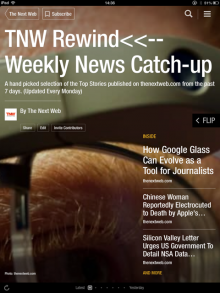
Photo credit: Thinkstock
Get the TNW newsletter
Get the most important tech news in your inbox each week.
